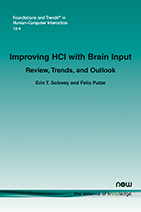Improving HCI with Brain Input: Review, Trends, and Outlook
By Erin T. Solovey, Worcester Polytechnic Institute, USA, esolovey@wpi.edu | Felix Putze, University of Bremen, Germany, felix.putze@uni-bremen.de
Abstract
In the field of HCI, researchers from diverse backgrounds have taken a broad view of application domains that could benefit from brain signals, both by applying HCI methods to improve interfaces using brain signals (e.g., human-centered design and evaluation of brain-based user interfaces), as well as integrating brain signals into HCI methods (e.g., using brain metrics in user experience evaluation). Recent advances in brain sensing technologies, new analysis methods, and hardware improvements have opened the door for such research, which will accelerate with the increased commercialization of wearable technology containing brain sensors. In this monograph, we examine brain signals from an HCI perspective, focusing on work that makes an HCI-related contribution. We pursue three main goals. First, we give a primer for HCI researchers on the necessary technology, the possibilities, and limitations for using brain signals in user interfaces. Second, we systematically map out the research field by constructing a taxonomy of applications, input paradigms, and interface designs. For this purpose, we reviewed more than 100 publications in major HCI conferences and journals. Finally, we identify gaps and areas of emerging work to lay a foundation for future research on HCI for and with brain signals.
Improving HCI with Brain Input: Review, Trends, and Outlook
As long as there have been computers, there has been a desire to integrate one’s thoughts directly with them. As the technology progressively comes into contact with human users, new challenges and opportunities arise that are central to human-computer interaction (HCI). In the field of HCI, researchers from diverse backgrounds have taken a broad view of application domains that could benefit from brain signals, both by applying HCI methods to improve interfaces using brain signals and integrating brain signals into HCI methods. Recent advances in brain sensing technologies, new analysis methods, and hardware improvements have opened the door for such research, which will accelerate with the increased commercialization of wearable technology containing brain sensors.
In this monograph, the authors examine brain signals from an HCI perspective, focusing on work that makes an HCI-related contribution. They pursue three main goals: (1) give a primer for HCI researchers on the necessary technology, possibilities, and limitations for using brain signals in user interfaces; (2) systematically map out the research field by constructing a taxonomy of applications, input paradigms, and interface designs; and (3) identify gaps and areas of emerging work to lay a foundation for future research on HCI for and with brain signals.
